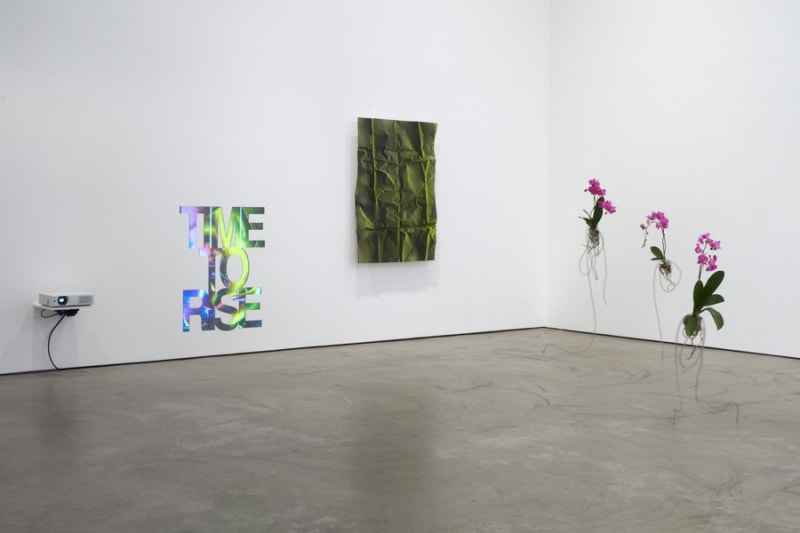Pennacchio Argentato's show at Wilkinson Gallery engages with information technology and the new algorithmic reality of a data control system, which constantly monitors our life with mechanisms of quantification, tracking, targeting and prediction.
The two artists deploy a futuristic landscape using the human body as a starting point, in order to visually and materially embody our relationship with technology, and focus on the bond between the human and the machine, and how these two are intertwined. The organic and the inorganic have been reorganised; the body has been enhanced through the use of high-tech performative material, and has been reconfigured through strategies of abstraction, repetition, enlargement and fragmentation.
The 3D animation of an eyeball continuously scans the space of the gallery, dominating the room from above. Hanging like a moon, this surveillance mechanism has an uncanny and threatening presence, it looks human but it moves like a machine, it has no tears nor blinks, it is perpetually open, never sleeping or resting. It engages directly with the power of control and with the feeling of being observed, with fear and paranoia. The goal of surveillance and the accumulation of data is to get inside our heads to predict the future of our actions, needs, thoughts and desires. It's a system of control where each one of our choices has already been calculated.
The floor based fragments of titanium body parts are arranged like empty shells, debris of physical bodies that have been technologically enhanced with metal skin, highly resistant to pressure and corrosion. It is an exoskeleton that provides protection for living in a world of high speed and boosted performance. And yet this smart skin has been peeled off, these shiny metallic limbs are presented like archeological remains from the near future. These empty prosthetic shells raise the question: What is a body able to do? They create a state of disorientation, suggesting that perhaps a new embodiment has taken place somewhere else. The body as a stage of the" here and now" and of "nowhere" at the same time.
‘Alternate futures’ is the title of the four sculptures hanging on the wall, they all have the same repeating shape of a thick sheet of wrinkled paper, but they present different solarised effects of colours, like the sculptures have been exposed and overexposed to different time and different light conditions. This solarisation effect is a photographic technique used since the beginning of photography, and was popularised by the surrealist photographer Man Ray in the 1930’s. He found this technique by accident when his assistant accidentally turned on the light in the dark room while a print was in the developer. The effect consists of partially reversed tones in an image recorded on a photographic negative or on a photographic print; the result is highly unpredictable and artificial.
In Pennacchio Argentato's sculptures the visual qualities of the photographic solarisation effect has been extended to the physical object itself, creating a rugged surface that presents its various depths and a variety of shifting colors. The matter looks so artificial, almost digital, the matter loses its consistency; it becomes lighter and constantly changing with different light conditions.
The text sculpture ‘Time to Rise’ functions as a screen for the projection of abstract mathematical fractals. In the 1970’s the Polish-born, French-American mathematician Mandelbrot developed the field of fractal geometry, he discovered that in nature underneath the complexity and the apparent chaos there is a repetitive order, there is self-similarity in everything, an endless repetition is observed zooming in and out of the pattern inherent in the matter. Mandelbrot found this hidden dimension of repeating patterns just trusting his eyes, he said: ‘I don't believe in formulas I believe in pictures.' This pattern has always been there but Mandelbrot was the first person to take note, and it took him twenty years to prove it with a mathematical formula.
Time to Rise is a sparkling glimmer on the dark sides of the future. It's a call to come out of the darkness and to look for the patterns, which make us human.
